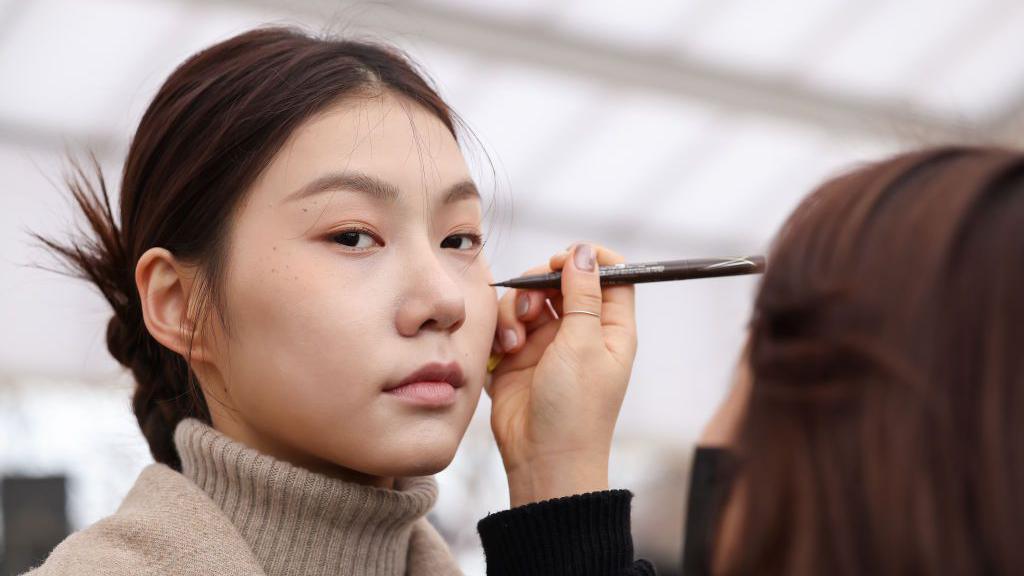While automobiles and smartphones are prominent South Korean exports to the US, beauty products from the Asian nation have cultivated a particularly devoted following.
K-beauty, encompassing a diverse array of skincare, makeup, and cosmetics from South Korea, is celebrated for its quality and value, contributing to a surge in demand in recent years.
The global popularity of South Korean culture has further propelled the appeal of its cosmetics.
Pearl Mak, a US-based consumer, shared with the BBC that her introduction to K-beauty products came through recommendations from friends. The 27-year-old graphic designer notes that South Korean serums are better suited for her skin compared to certain Western brands that tend to be more abrasive.
Now, she says, “95% of my skincare is made up of K-beauty products.”
Ms. Mak is among a growing number of Americans who favor South Korean skincare brands. Industry estimates suggest that US consumers spent $1.7 billion on K-beauty products in 2024, marking an increase of over 50% compared to the previous year.
K-beauty products are often priced more competitively than their Western counterparts and incorporate ingredients less commonly found in Western formulations, such as heartleaf and snail mucin.
US President Donald Trump has recently imposed a 15% import tax on South Korean goods traded between Seoul and Washington.
While lower than the 25% tariff initially threatened, many consumers are proactively responding to the change.
US-based K-beauty retailer Santé Brand reported a nearly 30% increase in orders in April, immediately following the announcement of sweeping US import taxes.
“When the tariff announcements hit, customers got strategic with how they were going to weather the storm,” Santé Brand’s founder, Cheyenne Ware, told the BBC.
“Consumers are preparing against the uncertainty.”
Another K-beauty retailer, Senti Senti, has increased its product orders since President Trump’s initial tariff threats, according to manager Winnie Zhong.
This week, suppliers have reportedly sent alerts to retailers, urging them to “stock up before tariffs” take effect.
Both retailers anticipate price increases for K-beauty products as the levies drive up costs across the industry.
“Anyone telling you prices will stay flat through the next two years is naive,” Ms. Ware stated.
Economist Munseob Lee from the University of California San Diego suggests that prices are likely to increase, particularly for smaller beauty product sellers on platforms like Amazon, which operate with narrow profit margins.
Despite potential price increases, Dr. Lee believes that the global popularity of South Korean culture will sustain demand for K-beauty products in the US.
“Casual buyers might be turned off by the higher price, but fans won’t find an easy substitute.”
Ms. Zhong concurs, anticipating that customers will continue purchasing K-beauty products, though potentially in smaller quantities.
For Ms. Mak, higher prices are unlikely to deter her from buying her preferred products.
“It depends on how much the price shoots up, but as of now, I am willing to pay more to purchase the same products,” she affirmed.
Eyal Victor Mamou, a business consultant based in South Korea, notes that larger K-beauty brands are better positioned to absorb the tariff costs compared to their smaller counterparts.
He suggests that these larger companies, benefiting from higher profit margins, can avoid significant price increases for their customers.
However, Mr. Mamou cautions that smaller K-beauty firms manufacturing their products in South Korea will face challenges in controlling costs.
“It will take some time to take effect since most goods being sold in the short-run have already been commissioned at current prices, but we’ll see it play out soon.”
In recent developments, President Trump has reached agreements with Japan and the European Union, subjecting their exports to the US to the same 15% tariffs as South Korea.
This development means that countries housing some of the world’s largest cosmetics brands now face the same levies as the K-beauty industry.
A core tenet of President Trump’s trade policies is his ambition to promote domestic manufacturing in the United States.
However, it remains to be seen whether these tariffs will lead US buyers to switch to American beauty products.
Ms. Mak indicates that US-made products do not currently appeal to her as alternatives.
“I do search for American-made alternatives often, but I have yet to find any that are as effective as the ones I use. So I wouldn’t go for American products yet.”
Several people were treated for smoke inhalation.
The reptile was retrieved by the officer and buckled into the back of a police car.
The comments come as Trump’s deadline for Russia to agree a ceasefire with Ukraine or face sanctions edges closer.
The redistricting would create five new Republican-leaning seats in the US House of Representatives.
About 3,200 workers who build F-15 fighter jets and other military aircraft voted to reject the firm’s latest contract deal.

